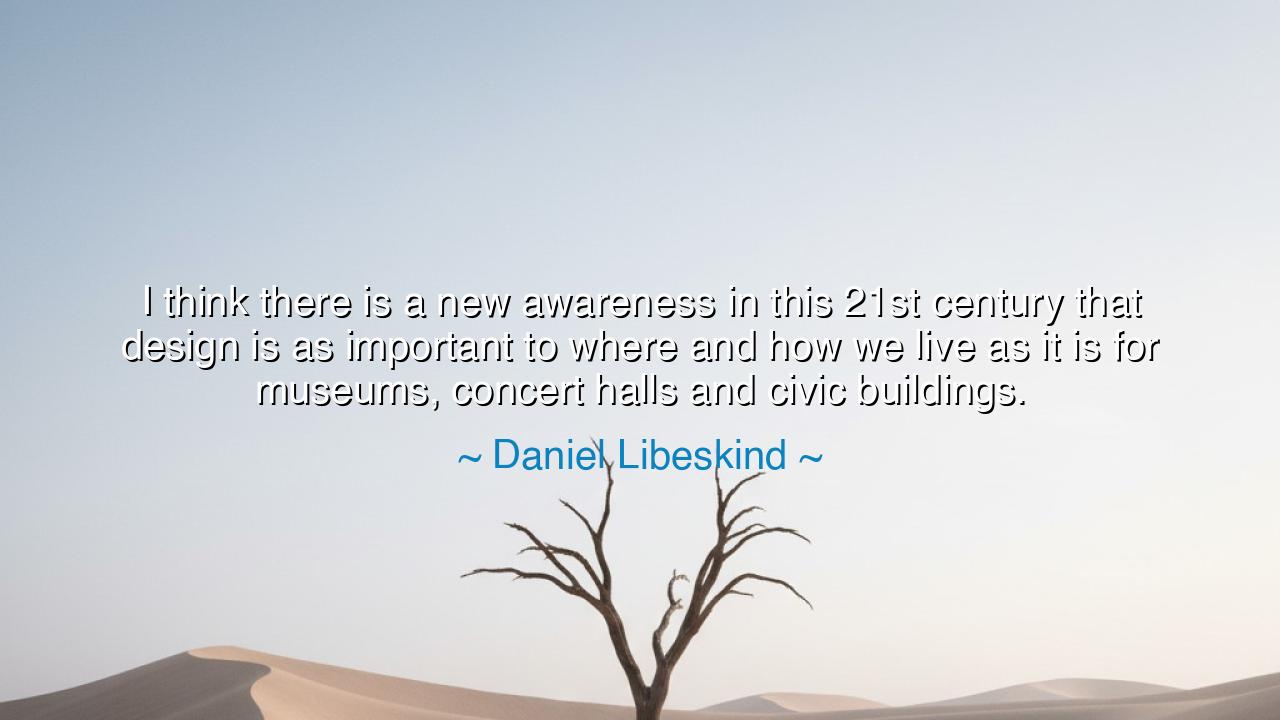
I think there is a new awareness in this 21st century that design
I think there is a new awareness in this 21st century that design is as important to where and how we live as it is for museums, concert halls and civic buildings.






The architect Daniel Libeskind, whose hands shaped spaces that breathe both memory and hope, once said: “I think there is a new awareness in this 21st century that design is as important to where and how we live as it is for museums, concert halls, and civic buildings.” These words, born from the union of art and humanity, call us to recognize that design is not the privilege of grand institutions alone — it is the silent companion of our daily lives, the unseen architect of our moods, our thoughts, and our sense of belonging. In this statement, Libeskind reveals a profound truth: that beauty and intention must dwell not only in the monumental, but in the intimate; not only in what we visit, but in what we inhabit.
To understand his wisdom, one must first know his story. Daniel Libeskind, the son of Holocaust survivors, came of age with an awareness of both destruction and renewal. His architecture has always sought to heal the wounds of history through form and light. In designing the Jewish Museum in Berlin, he created not a mere building, but a dialogue between memory and space — walls that echo absence, corridors that speak of loss, light that carries redemption. Yet his insight in this quote looks beyond monuments. It asks us to see that design, the thoughtful shaping of our environment, must belong to every human dwelling — from the humble home to the city street. For the spaces where we live shape not only our comfort, but our consciousness.
When Libeskind speaks of a “new awareness,” he calls forth a change in how civilization perceives the role of design. In earlier centuries, beauty and artistry were reserved for temples, palaces, and cathedrals — places meant for gods, kings, or the collective pride of a nation. The common home was left to utility alone, built for survival, not for spirit. But in the 21st century, a new understanding has emerged: that design is a moral act, that the quality of our surroundings influences the quality of our lives. Light, proportion, texture, openness — these are not luxuries, but necessities of the human soul. The ancients understood this truth: that to build is to honor life itself. The temples of Greece, though made of stone, were shaped to reflect harmony with the sky, the sea, and the mind of man.
In our modern age, this ancient wisdom is being rediscovered. Across the world, architects, designers, and citizens alike are awakening to the realization that where we live should nourish us as deeply as the art we admire. A well-designed home, school, or public park becomes a place where creativity and peace take root. Consider the story of Jane Jacobs, who in the mid-20th century fought against the destruction of neighborhoods in New York City. She understood, long before many did, that cities are living organisms — that their design must serve human connection, not merely convenience. Her efforts preserved not only buildings, but communities, proving that thoughtful design could protect the very fabric of society.
Libeskind’s vision carries forward that same spirit. To him, design is not an ornament, but a force — the invisible hand that shapes how we think, feel, and relate to one another. The arrangement of light in a room, the openness of a city square, the flow of air and sound — all these elements create an emotional language that speaks directly to the soul. A space that honors its inhabitants gives dignity to life; a space that neglects them drains it. Thus, the architect, the planner, even the craftsman, becomes not merely a builder, but a poet of the human experience.
In this way, Libeskind’s quote is both a reflection and a summons. He sees that the 21st century, with all its noise and speed, is yearning for depth — for places that calm the spirit and remind us of our humanity. It is no longer enough for museums and concert halls to be the sole bearers of beauty; our homes, our workplaces, even our streets must participate in the same act of creation. The sacred must return to the ordinary, the extraordinary to the everyday. This is the new awareness he speaks of — a collective realization that design, at its truest, is not decoration, but meaning made visible.
So, my listener of the future, let this truth guide you: whatever you build, whether of stone or of habit, design it with care. Make your home a sanctuary for thought, your workplace a vessel of inspiration, your public spaces mirrors of harmony. Do not think of design as the privilege of artists, but as the responsibility of all who shape the world — through architecture, through craft, through the way they arrange their own lives. For how we dwell reflects who we are, and how we design our world determines the soul of our civilization.
Let Daniel Libeskind’s words echo as both wisdom and warning: “Design is as important to where and how we live as it is for museums, concert halls, and civic buildings.” Remember that beauty and function, form and feeling, belong to everyone. When you shape your surroundings with purpose, you are not merely decorating space — you are elevating life. And in doing so, you take part in the oldest and noblest of human endeavors: the act of turning existence itself into art.






AAdministratorAdministrator
Welcome, honored guests. Please leave a comment, we will respond soon